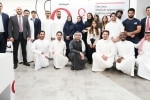The GCC’s national oil companies (NOCs) must put AI to work if they are to keep delivering the world’s lowest cost and lowest carbon footprint barrels. To achieve this, NOCs need organizational cultures that can quickly produce many small, high-impact artificial intelligence (AI) applications.
AI-powered solutions are the next major cost and efficiency frontier in the oil and gas industry. Leading oil majors are already using them to produce oil faster, at lower cost and resource intensity. For example, AI can accelerate subsurface analysis, reduce uncertainty, and optimize capital allocation. Shell partnered with startup Avathon (formerly SparkCognition) and is using AI-powered deep learning to reduce seismic shots by 99%, maintaining image accuracy while cutting exploration time from nine months to just nine days.i
AI also can enhance well planning, automate drilling, predict conditions, and streamline workflows. ExxonMobil, collaborating with IBM, used AI to reduce well planning and design time from nine to seven months, and cut data preparation time by 40%.ii Also, AI can analyze real-time downhole data, optimize rate of penetration, and predict failures. Machine learning can adjust drilling parameters dynamically, reducing non-productive time, cutting costs, and improving well economics. ConocoPhillips used three years of drilling data to develop a machine learning model that improved vertical rate of penetration by 20% and reduced premature drilling-motor failures by 65%—saving $30,000 per well.iii
Similarly, AI can track emissions in real time, detect leaks, and increase carbon capture. Chevron deployed AI to optimize methane emissions reduction in upstream operations, helping cut methane emission intensity by 60%.iv
The GCC’s NOCs can develop a broad-based, AI-solutions portfolio that drives immediate, incremental gains and mitigates the risk of being outpaced in the AI race. These solutions can drive down costs, support better exploration and investment decision-making, accelerate field development, optimize drilling efficiency, and reduce emissions without cutting production. We estimate that AI applications can reduce the upstream operating costs of the GCC’s NOCs by 10-15% — approximate annual savings of $3–4.5 billion.
The region’s NOCs need a new approach. In the past, they have gone slow-and-steady with large-scale digital initiatives. That meant a robust cycle of requirements definition, vendor selection, and at-scale implementation that took years to come to fruition.
Instead, GCC NOCs need a distributed AI capability and a cultural shift. The change in culture encourages and enables people quickly to learn from peers, experiment with applications, and rapidly deploy what works. That allows for the simultaneous development of AI solutions within a NOC’s businesses and functions. The incremental gains produced by each solution will accumulate over time.
NOCs can build their AI capability through strategic partnerships with AI startups, collaboration with technology providers, and investments in their own expertise. This effort should be business-led, not IT-led. It should teach engineers and analysts to use AI tools efficiently and bring them together into small, cross-functional teams that contain the business and technical knowledge needed to drive improvement.
These teams need a three step, agile approach to AI experimentation.
- First, a rapid review to identify initial, high-priority pockets of inefficiency in which traditional methods have reached their limits, and AI can unlock productivity gains with minimal complexity.
- Second, use case selection to assess AI solutions based on their impact and ease of implementation, and to prioritize high value, quick wins.
- Third, rapid prototyping and scaling to ensure the most effective solutions reach enterprise-wide adoption.
To succeed, such an approach requires a cultural shift. Such change will value speed over perfection, accept experimentation, and tolerate early-stage failure. It also requires leaders to empower teams to test, learn, and scale with minimal oversight and bureaucracy.
NOCs that quickly build a capability for AI and successfully foster a culture of experimentation and empowerment will be able to rapidly produce many small, high-impact AI applications that drive immediate gains. Over time, as more solutions emerge from this environment, they can interconnect like pieces of a puzzle, creating a cohesive, AI-driven organization.
This article originally appeared in Oil Review Middle East, May 2025.
In the news
Capturing the AI advantage through culture change
The GCC’s national oil companies (NOCs) must put AI to work if they are to keep delivering the world’s lowest cost and lowest carbon footprint barrels. To achieve this, NOCs need organisational cultures that can quickly produce many small, high-impact artificial intelligence (AI) applications

Contact us




















Menu